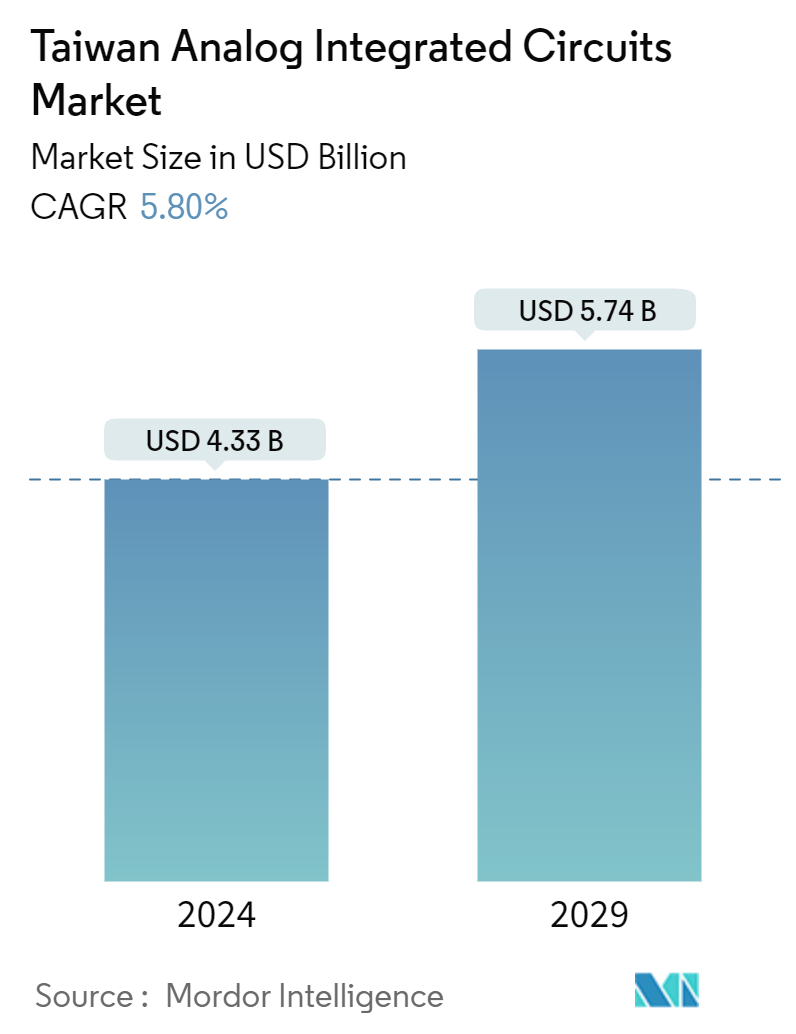Market Size of Taiwan Analog Integrated Circuits Industry

| Study Period | 2019 - 2029 |
| Base Year For Estimation | 2023 |
| Market Size (2024) | USD 4.33 Billion |
| Market Size (2029) | USD 5.74 Billion |
| CAGR (2024 - 2029) | 5.80 % |
| Market Concentration | Low |
Major Players
*Disclaimer: Major Players sorted in no particular order |
Taiwan Analog Integrated Circuits Market Analysis
The Taiwan Analog Integrated Circuits Market size is estimated at USD 4.33 billion in 2024, and is expected to reach USD 5.74 billion by 2029, growing at a CAGR of 5.80% during the forecast period (2024-2029).
- Analog IC has gained traction in recent years due to the proliferation of smartphones, consumer electronics, computers, and storage devices, as well as the increased sales of electric vehicles. Various ICs used in smartphones include charge IC, display PMIC, SoC PMIC, and Camera PMIC. Players such as Apple, Qualcomm, Intel, and Samsung S.LSI are leading in this market. Therefore, with the growing production and sales of smartphones with better technologies and the surging incorporation of 5G and 6G in Taiwan, the analog IC market is expected to gain a vast share of traction globally.
- Moreover, the increasing 5G networking capabilities in Taiwan are expected to create a massive demand for analog IC modules. In March 2024, Ericsson partnered with Taiwanese carrier Chunghwa Telecom through an MoU to enhance 5G technology in Taiwan. This collaboration focuses on advancing and commercializing technologies related to the 3GPP Release 18. Set to be officially frozen in March 2024, Rel-18 marks the inception of 5G-Advanced technology. These advancements are expected to lay the groundwork for future 6G networks, ensuring a smooth transition from 5G to 6G.
- With the rise of EVs (electric vehicles) and advanced driver-assistance systems (ADAS), there is an increasing need for analog ICs in automotive applications. Taiwan's focus on the automotive sector is boosting the demand for analog integrated circuits (IC). In addition, as Taiwan continues to advance in industrial automation, there is a growing need for analog ICs in applications such as motor control, sensors, and power management.
- Taiwan's government actively supports the semiconductor industry through policies, subsidies, and investments in research and development (R&D), further fueling the growth of analog integrated circuits (ICs). The new incentives include proposals to attract overseas or international semiconductor talent and equipment/materials suppliers. Government policies and incentives are expected to improve Taiwan's semiconductor ecosystem in the coming years.
- Modern IC technology grapples with significant design challenges. Advanced technology nodes show marked variability during manufacturing. Additionally, running various devices on these cutting-edge ICs amplifies this variability, leading to operating voltage, temperature, and performance changes. To maintain essential qualities like fidelity, precision, and consistency, the analog design must skillfully navigate these variabilities, challenging the market's expansion.
- Macroeconomic factors like increasing inflation and interest rates further decrease consumer spending, which restricts the growth of the market studied. The geopolitical issues, particularly between Taiwan and China, are significant concerns. China's military exercises and trade restrictions pose a threat to Taiwan's trade-dependent economy. Any disruptions in trade relationships, especially with China, a significant export market, can severely impact Taiwan's analog IC market.

